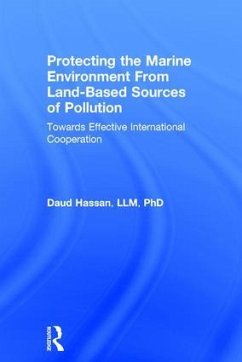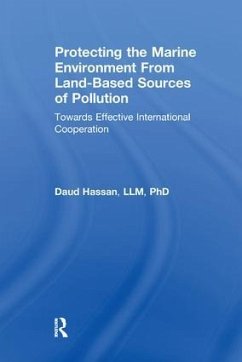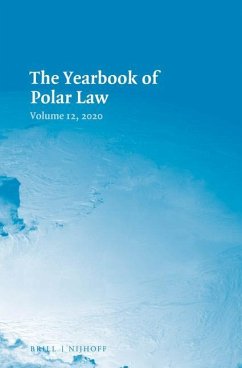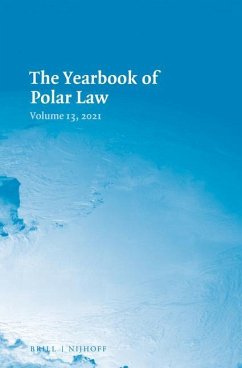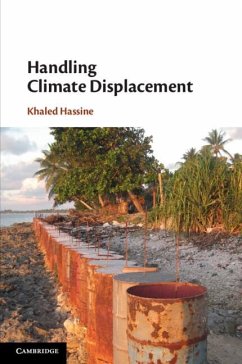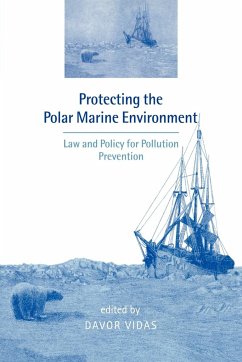
Protecting the Polar Marine Environment
Law and Policy for Pollution Prevention
Herausgeber: Vidas, Davor; Davor, Vidas
Versandkostenfrei!
Versandfertig in 1-2 Wochen
42,99 €
inkl. MwSt.
Weitere Ausgaben:

PAYBACK Punkte
21 °P sammeln!
Comparative analysis of regulations in protecting the Arctic and Antarctic against pollution.How can we best protect the polar marine environment against pollution? Leading scholars on environmental law, the law of the sea, and Arctic and Antarctic affairs here examine this important question. To what extent do existing global instruments of environmental protection apply to the Arctic Ocean and the Southern Ocean? Can the arrangements adopted at regional, sub-regional and national levels provide adequate protection? This book examines and compares various levels of regulation in protecting th...
Comparative analysis of regulations in protecting the Arctic and Antarctic against pollution.
How can we best protect the polar marine environment against pollution? Leading scholars on environmental law, the law of the sea, and Arctic and Antarctic affairs here examine this important question. To what extent do existing global instruments of environmental protection apply to the Arctic Ocean and the Southern Ocean? Can the arrangements adopted at regional, sub-regional and national levels provide adequate protection? This book examines and compares various levels of regulation in protecting the marine environment of the Arctic and Antarctic, with specific attention to land-based activities, radioactive waste dumping, and shipping in ice-covered waters. Developments since the establishment of the Arctic Council in 1996 and the entry into force of the Protocol on Environmental Protection to the Antarctic Treaty in 1998 are also discussed. This is a volume that will appeal to polar specialists and to all those interested in environmental law and policy.
Review quote:
'(?)0; the volume recommends itself for combining updated information with thought-provoking analysis, as was to be expected from the leading legal authorities in polar or marine issues who contributed to it.' Journal of Polar Record
Table of contents:
List of figures; List of tables; Notes on the contributors; Preface and acknowledgements; List of abbreviations; Introductory overview. Protecting the polar marine environment: interplay of regulatory frameworks Davor Vidas; Part I. Levels of Regulation in the Protection of the Polar Marine Environment: 1. Globalism and regionalism in the protection of the marine environment Alan Boyle; 2. United Nations Convention on the Law of the Sea and the polar marine environment Budislav Vukas; 3. Global environmental protection instruments and the polar marine environment Donald R. Rothwell; 4. The polar marine environment in regional cooperation Davor Vidas; 5. Protection of the Antarctic environment against marine pollution under the 1991 Protocol Christopher C. Joyner; 6. Sub-regional cooperation and protection of the Arctic marine environment: the Barents Sea Olav Schram Stokke; 7. Domestic perspectives and regulations in protecting the polar marine environment: Australia, Canada and the United States Donald R. Rothwell and Christopher C. Joyner; Part II. Current Trends and Issues in Protecting the Polar Marine Environment: 8. Land-based marine pollution and the Arctic: polarities between principles and practice David VanderZwaag; 9. Radioactive waste in the Barents and Kara Seas: Russian implementation of the global dumping regime Olav Schram Stokke; 10. Regulation of navigation and vessel-source pollution in the Northern Sea Route: article 234 and state practice R. Douglas Brubaker; 11. The emerging International Polar Navigation Code: bi-polar relevance? Lawson W. Brigham; Index of international instruments and national legislation; Subject index.
How can we best protect the polar marine environment against pollution? Leading scholars on environmental law, the law of the sea, and Arctic and Antarctic affairs here examine this important question. To what extent do existing global instruments of environmental protection apply to the Arctic Ocean and the Southern Ocean? Can the arrangements adopted at regional, sub-regional and national levels provide adequate protection? This book examines and compares various levels of regulation in protecting the marine environment of the Arctic and Antarctic, with specific attention to land-based activities, radioactive waste dumping, and shipping in ice-covered waters. Developments since the establishment of the Arctic Council in 1996 and the entry into force of the Protocol on Environmental Protection to the Antarctic Treaty in 1998 are also discussed. This is a volume that will appeal to polar specialists and to all those interested in environmental law and policy.
Review quote:
'(?)0; the volume recommends itself for combining updated information with thought-provoking analysis, as was to be expected from the leading legal authorities in polar or marine issues who contributed to it.' Journal of Polar Record
Table of contents:
List of figures; List of tables; Notes on the contributors; Preface and acknowledgements; List of abbreviations; Introductory overview. Protecting the polar marine environment: interplay of regulatory frameworks Davor Vidas; Part I. Levels of Regulation in the Protection of the Polar Marine Environment: 1. Globalism and regionalism in the protection of the marine environment Alan Boyle; 2. United Nations Convention on the Law of the Sea and the polar marine environment Budislav Vukas; 3. Global environmental protection instruments and the polar marine environment Donald R. Rothwell; 4. The polar marine environment in regional cooperation Davor Vidas; 5. Protection of the Antarctic environment against marine pollution under the 1991 Protocol Christopher C. Joyner; 6. Sub-regional cooperation and protection of the Arctic marine environment: the Barents Sea Olav Schram Stokke; 7. Domestic perspectives and regulations in protecting the polar marine environment: Australia, Canada and the United States Donald R. Rothwell and Christopher C. Joyner; Part II. Current Trends and Issues in Protecting the Polar Marine Environment: 8. Land-based marine pollution and the Arctic: polarities between principles and practice David VanderZwaag; 9. Radioactive waste in the Barents and Kara Seas: Russian implementation of the global dumping regime Olav Schram Stokke; 10. Regulation of navigation and vessel-source pollution in the Northern Sea Route: article 234 and state practice R. Douglas Brubaker; 11. The emerging International Polar Navigation Code: bi-polar relevance? Lawson W. Brigham; Index of international instruments and national legislation; Subject index.





